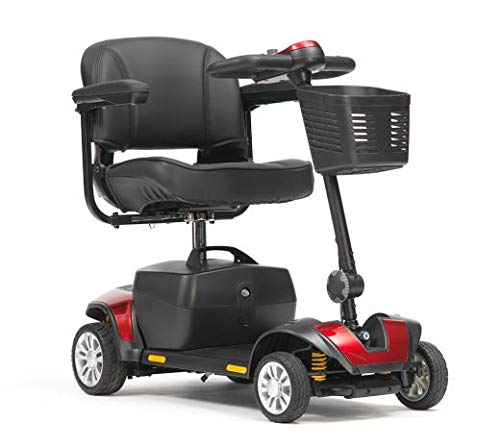Is Pavement Mobility Scooter The Same As Everyone Says?
2024.07.25 13:21
 How to Choose the Best Pavement mobility scooter on pavement (http://xilubbs.xclub.tw/space.php?uid=1714708&do=profile) Scooter
How to Choose the Best Pavement mobility scooter on pavement (http://xilubbs.xclub.tw/space.php?uid=1714708&do=profile) ScooterThe hustle and bustle of streets and busy sidewalks is no easy feat However, armed with the proper mobility scooter, it can be a breeze.
One of the main factors to take into consideration when purchasing the pavement scooter is the incline rating. A higher rate of incline indicates that the scooter can climb higher inclines or rough terrains with no slowing.
Easy to Manoeuvre
A mobility scooter that is parked on the pavement is a great means to get around in tight spaces, crowded streets, and bustling towns. These vehicles feature a sleek design that allows for easy maneuvering through tight streets and urban areas, and come with features like intelligent brakes, bright LED lighting as well as anti-tip mechanisms and user-friendly controls. Some vehicles have suspension systems that make riding on uneven surfaces more comfortable.
Test the controls prior to deciding to buy a scooter. Move the accelerator lever left and right and up and down. It is also important to determine whether you can reach all the controls and operate them without straining your body or twisting it too excessively. If you're not able to do this then you should talk to your dealer about installing adjustable controls.
You can drive a class 2 or 3 mobility scooter on pavements that go up to 4mph, however pedestrians may not hear the vehicle approaching. Avoid driving your scooter on bus or cycle lanes and avoid driving on dual carriageways since this could put you at risk of being struck by a car.
All scooters are able to climb kerbs as high as 2.5cm (or 1 inch) However, it's crucial to walk towards them at the correct angle so you don't tip over and cause injury to yourself. Refer to the directions for your scooter or ask your retailer if you're uncertain of the maximum kerb-climbing ability.
The most effective tyres to use on a scooter that is paved are pneumatic tyres that can be inflated with the bicycle air pump. They are smoother and can absorb bumps better but they must be properly filled in order to avoid punctures. Solid tyres don't give as much cushioning but they don't need to be inflated so regularly and are less likely to puncture.
Many scooters on pavements have an anti-tip device that is fitted behind the rear wheels to stop them from tipping backwards on a steep slope. If your scooter isn't equipped with this feature, ask your local retailer whether they can install it for you.
Comfortable to ride
Most scooters prioritise comfort and come with a variety of features that improve the overall experience. For instance, a cushioned seat and adjustable armrests ensure smooth rides even on uneven or bumpy terrain.
Some scooters are also equipped with suspension systems that help reduce vibrations and jolts and provide a remarkably comfortable experience. You can also add LED lighting to your scooter to improve visibility and ensure safety in low lighting conditions.
Another crucial aspect to consider when shopping for an electric scooter is the speed. A class 3 scooter is able to drive on the pavements and main roads at speeds of up to 4mph, which gives you plenty of freedom to travel further afield. However, it's important to be aware of other road users and be a responsible driver.
It is recommended to always be driving at a reasonable speed and use kerbs that are dropped whenever possible to avoid having to climb over them. It's a good idea practise climbing kerbs on flat surfaces prior to buying your scooter to help learn to handle the process.
When selecting a scooter, ensure that it has the freewheel feature that allows you to turn your wheels without having to activate the brakes. This feature is beneficial when you are navigating your scooter around an awkward corner at home or while driving around town. Many scooters are equipped with front and rear lights to improve visibility. Adding a horn to your scooter can also help you alert pedestrians to your presence, which makes it safer to drive through crowds of people.
It's a great option to have a mobility scooter that has a battery indicator. This will inform you when it is time to recharge your batteries. Keep your batteries fully charged to prolong the lifespan of your scooter. You should also check your scooter's controls regularly for example, the brake system, to ensure everything is functioning properly.
Storage and portability is useful.
A pavement scooter is a great way to get around town without relying on public transportation. They can be used for errands, shopping, as well as visiting relatives and friends. The compact size of these scooters makes them easy to carry and store. They also come with comfortable captain's chairs and adjustable armrests for increased security and comfort.
There are many kinds of pavement scooters on the market, so it's important to choose one that fits your requirements and lifestyle. Some are designed for indoor use while others are designed for outdoor use. The type of tire you choose will affect the performance and the comfort of your scooter. You can pick between pneumatic, solid, or foam-filled tires. Solid tires are stronger and can withstand greater pressure, whereas pneumatic tires give an easier ride.
Another benefit of a mobility scooter on pavements is its tight turning radius, which allows it to maneuver easily within narrow spaces. This feature will prevent you from getting stuck on narrow roads. It also helps you make an easy turn when driving through an area that is crowded.
Pavement mobility scooters tend to be lighter than other scooters. This makes them easy to transport and they are also easier to put together. The majority of models have foldable or removable components that allow them to be transported within small spaces. Some models also have batteries that are removable which can help decrease the weight and battery cost.
If you are considering buying a scooter, it is important to take into consideration your needs and consult an expert in mobility or a healthcare professional. They can suggest the best model for you and answer any questions you may have. They will also give you details on how to operate the scooter, as well as safety tips.
If you're looking for a stronger scooter that can be driven on roads as well as pavements, look into a 6--8 mph road scooter. These scooters are larger than pavement scooters, but they offer more power and can travel farther distances. Some even feature indicators and headlights, which improve visibility for other drivers and pedestrians.
Long battery life
Battery life is one of the factors that you should consider when shopping for a mobility scooter. Depending on how frequently you use it, the kind of battery you choose and how you maintain it, your mobility scooter can go up to twice as long between charges.
Most mobility scooters are powered by two 12 Volt batteries that are wired in series, delivering 24 Volts. These batteries can be any size or type so long as they fit inside the compartment of your scooter and are compatible with your scooter's charger. If you wish to extend the lifespan of your batteries, we recommend using smart chargers that will prevent overcharging and undercharging.
It is also important to take into consideration the amp hour rate of batteries. This is a measure of the amount of energy it will hold and is displayed on the battery case, for example 12 Volt 35AH. To get the most out of your battery, always recharge it after every journey and at night.
The distance a mobility scooter can travel between charges is determined by the weight of the user and their accessories as well as the size of the engine and speed, and the battery capacity. All-terrain scooters can travel twice as far between charges as folding models that are lightweight.
The maximum incline rating of the scooter is a different aspect to take into consideration. This refers to the scooter's ability to go up steep hills, and is typically given in degrees or percentages. The higher the number the steeper the ability to climb hills.
 For users who want to ride their scooters out on the road, Class 3 vehicles permit 4mph on pavements as well as indoor spaces, and offer the most robust motor for longer rides. They also come with headlights, hazard lights, and indicators to enhance visibility. These are ideal for people who travel long distances frequently and want an easy, comfortable ride. For more information on these models, speak to an expert mobility dealer.
For users who want to ride their scooters out on the road, Class 3 vehicles permit 4mph on pavements as well as indoor spaces, and offer the most robust motor for longer rides. They also come with headlights, hazard lights, and indicators to enhance visibility. These are ideal for people who travel long distances frequently and want an easy, comfortable ride. For more information on these models, speak to an expert mobility dealer.